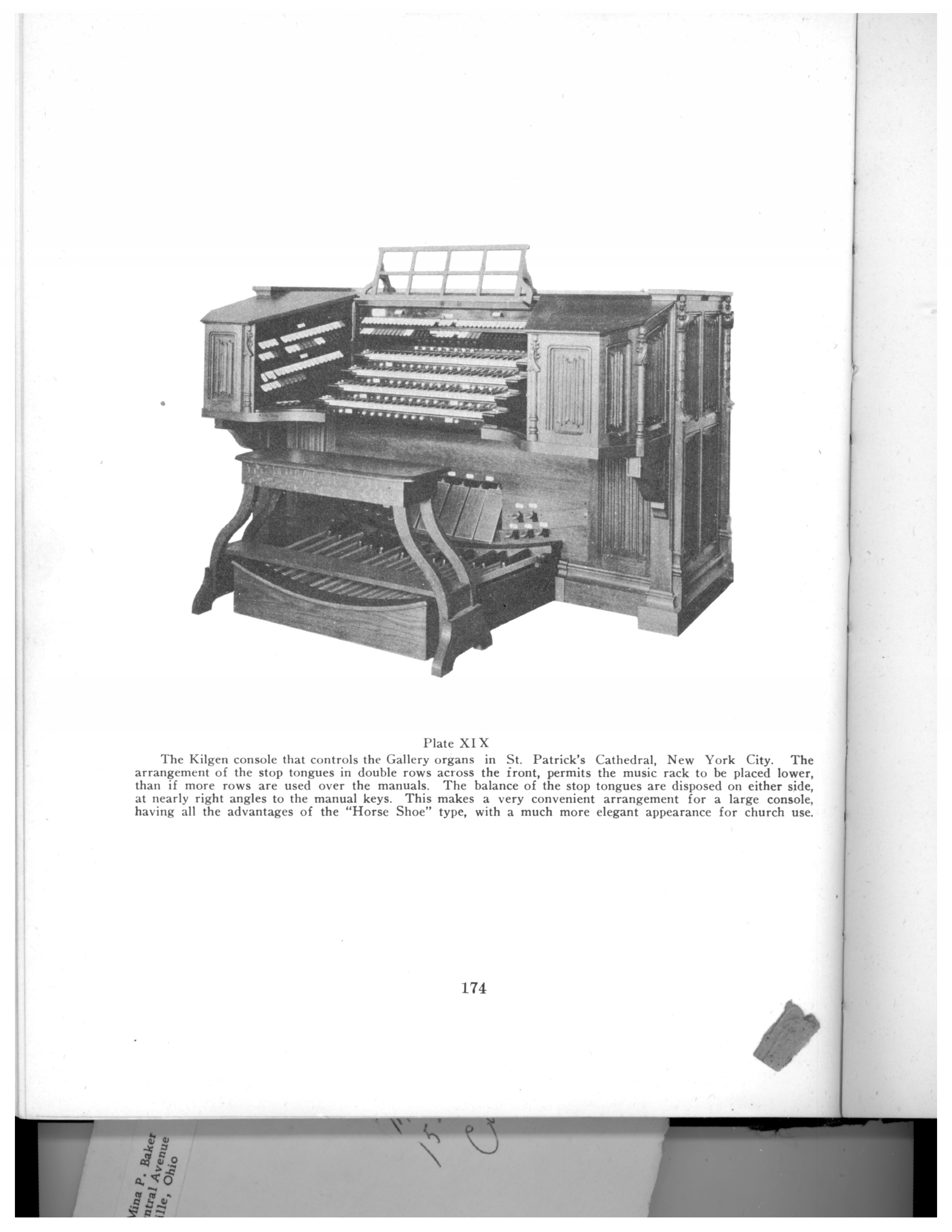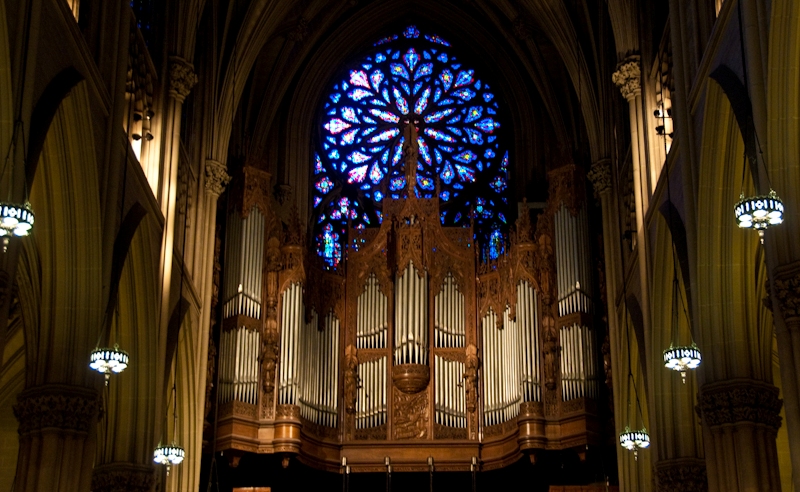
1933 - Console (Photograph from an archival source: "The Contemporary American Organ", William H, Barnes/Jeff Scofield)

unknown - Gallery Organ (Photograph from an archival source: From a website, submitted by Paul R. Marchesano/Paul R. Marchesano)


2004-10-30 - Status Note: There 1995. -Database Manager
2004-10-30 - Gallery organ. 99 voices, 59 borrows, 8232 pipes. Dedicated 11 Feb 1930. Revoiced 1977-1977 by John H. Steinkampf, with additions. Pitch raised to A440. Gallery and echo organs mechanically restored and cleaned by Pergallo Organ Co. (1990's?). Two 5m consoles added by Robert M. Turner to control both gallery and chancel organs. -Database Manager
2009-08-10 - Updated through online information from Paul Marchesano. -Database Manager
2011-01-26 - Updated through online information from Jonathan Farnsley. -- It has two identical 5 manual consoles. -Database Manager
2023-06-26 - The international concert organist Pietro Yon became organist in 1926, playing the four-manual 1879 Jardine. He was responsible for the purchase of two organs for the church, a three-manual near the altar, and a separate four-manual instrument in the gallery, which required a replacement of the original wooden gallery, with one substantially larger, of concrete and steel. The chancel organ was installed first in 1928 and the gallery followed in 1930. The design of the gallery organ was largely influence by organist Yon, and was a triumph for Kilgen, selling many instruments to catholic churches on the reputation of the cathedral organ. He was reportedly a stickler during the organ's installation, insuring the voicing was "just so" and to his high standards. Kilgen likely lost money on the project, but it was so visible and sold so many organs for them, they undoubtedly made it up and considered it a wise marketing investment. Yon was succeded by Charles Courboin in 1940, who over the course of the next 30 years made minor revisions and additions to Yon's specification. Courboin, previously the organist at the Wanamaker store, received national television coverage in the 1960s with the annual Christmas Eve Midnight Masses broadcast nationally on NBC, and Robert Kennedy's funeral in 1969. He was succeeded in 1970 by John Grady, who was responsible for many serious changes to the instrument in 1977-78, which spoiled its original elegant tone. The principals and mixtures were loudened, and the English-style reeds were revoiced in a quasi-french style by Jack Steinkampf of Queens, who also added the infamous Trompette-en-chamade. An article published in The American Organist in the late 1980s called attention to the ruinous condition of the organ. The article described an instrument close to becoming unplayable with a failing and unreliable combination action; sub-standard fire-hazard wiring; reservoirs and wind lines rife with wind leaks; added chests and offsets placed anywhere there was room, making access to certain parts of the organ for repair or service nearly impossible; zinc basses were found stashed in corners along with ranks of pipes on the floor under reservoirs; large pipes were collapsing; dead notes and stops were numerous; and the instrument was choked with dirt. The instrument was finally overhauled by the Peragallo company in the early 1990s under the tenure of John -Michael Caprio, with the intention of rationalizing the many amateur additions, changes, and wiring. How much of the original organ remains after this work needs a careful forensic analysis. The notorious "Jeu de Bombardes", a chorus of painful and unnecessarily loud reeds was added at this time, as were another 30 ranks, plus additional imitation 32' stops.. The signature Kilgen horseshoe console with its delicately-carved linen-fold panels and colored stop tablets (red for reeds, black for couplers) was discarded, and two identical drawknob consoles crafted by Robert Turner replaced both the front and gallery consoles, with the altar organ now controllable from either console. Whether the organ was again revoiced at this time or the current painfully-loud and brilliant organ is the result of the 70s revoicing also needs confirmation, but the sound of the present instrument bears no relation to the elegant and polished organ Kilgen installed in 1930 and which was still the predominant ensemble tone heard through the 60s and early 1970s. The organ's original English chorus reed tone was quite fine, a far cry from the coarse, Americanized french reeds now dominating the ensemble. The manner in which the 1970s revoicing was done, especially of the reeds, was so invasive as to be effectively irreversible. At the time of its installation in 1930, the facade, (designed by the architect responsible for the modernization of th interior), was considered the most beautiful new organ case in America. The facade pipes were coated with a bright zinc coating that gave the effect of tin. This had dulled over the course of time and for decades people thought the facade pipes were raw unfinished zinc- another popular facade treatment of the teens and twenties. The shiny zinc coating was replicated in the Peragallo rebuilding, and covered with a clear top-coat to prevent future dulling by oxidation. The facade and its pipework again shines with its original lustre. -Scot Huntington
2023-07-15 - An article in *The American Organist*, November 1962, announced the completion of the organ's rebuild by local maintenance person Eric Sexton, planned and overseen by organist Charles Courboin. The chorus Mixtures were all reconfigured or replaced, as was the Great Principal chorus. Two main chorus stops, both extensions, received new independent ranks: Great Octave 4' and Solo Tuba Clarion 4'. Several new chorus reeds were added. In all, 30 ranks were replaced, and the String Organ was reduced in size. The Pedal Diaphone also disappeared at this time. Thus began a continuous, decades-long evolution of the Kilgen magnum opus away from its original symphonic design. -Scot Huntington
Masters Thesis, author unknown; Union Theological Seminary Source: From console 1940
Geo. Kilgen & Son, Inc. (Opus 5918, 1930)
St. Patrick's Catholic Cathedral
New York City: Manhattan, New York
Compasses: 61/32
GREAT SWELL
16' Diapason [unit] 85 pipes 16' Salicional [unit] 97 pipes
16' Bourdon [unit] 85 16' Bourdon [unit] 97
8' 1st Diapason 61 8' Diapason Phonon 73
8' 2ndDiapason fr. 16' 8' Open Diapason 73
8' Horn Diapason 61 8' Small Diapason [unit] 85
8' Philomela 61 8' Stopped Flute 73
8' Clarabella 61 8' Flute Harmonic 73
8' Gamba 61 8' Viol d'Gamba 73
8' Doppel Flute 61 8' Viole d'Orchestre 73
8' Violoncello 61 8' Viole Celeste 73
8' Gedeckt fr. Bdn. 8' Salicional fr. Sal.
8' Viol d'Amour 85 8' Voix Celeste 73
4' Diapason fr. 16' 8' Clarinet Flute fr. Bdn.
4' Principal 61 4' Prestant fr. Small
4' Claribel Flute 61 4' Violina 73
4' Flute Harmonic 61 4' Salicional fr. Sal.
4' Viola fr. Vd'A 4' Forest Flute 73
2 2'3 Nazarde fr. Vd'A 4' Dolce Flute fr. Bdn.
2' Flute Octaviante fr. Bdn. 2' Flautino 61
IX Ripieno 549 V Ripieno 305
16' Posaune 61 III Dolce Cornet 183
8' Tromba [unit] 73 16' Contra Fagotto 73
4' Tromba Clarion fr. Tr 8' Cornopean 73
Chimes SO 8' Corno di Bassetto 73
8' Oboe [unit] 85
4' Oboe Clarion fr. 8'
16' Bass Vox Humana [unit] fr. VH
8' Solo Vox Humana [unit] 85
4' Soprano Vox Humana fr. VH
STRING ORGAN
Tremolo
CHOIR SOLO
16' Quintone 85 pipes 16' Contra Gamba [unit] 85 pipes
16' Contre Viole [unit] 85 8' Stentorphone 73
8' English Diapason 73 8' Flauto Major 73
8' Violin Diapason 73 8' Gross Gamba fr. 16'
8' Tibia Minor 73 8' Gamba Celeste [t.c.] 61
8' Concert Flute [unit] 85 8' Clarabella 73
8' Flute Celeste [t.c.] 61 8' Concerto Viola II rks. 134
8' Viola Sorda 73 4' Octave 73
8' Quintadena fr. 16' 4' Flute Ouverte 73
8' Cor de Nuit 73 4' Fugara 73
8' Cor de Nuit Celeste 73 16' Tuba Profunda [unit] 97
8' Viola fr. 16' 8' Tuba Sonora 73
4' Flauto Traverso fr. CF 8' Tuba Harmonic fr. 16'
4' Flute a Cheminee 73 8' English Horn [orchestral] 73
4' Salicet 73 8' Liturgical Trumpet[brass] 73
4' Violetta fr. 16' 4' Tuba Clarion fr. 16'
II Tertian 122 Chimes 25 tubes
2' Super Viola 61 STRING ORGAN
2' Piccolo fr. CF Tremolo
8' French Horn 73
8' Clarinet 73
8' Orchestral Oboe 73
Harp Celesta 61 bars
STRING ORGAN
Tremolo
PEDAL STRING ORGAN [floating]
64' Gravissima -- 16' Contra Salicional [unit] 97 pipes
32' Diapason [unit] 44 pipes 8' Viole d'Orchestre 73
32' Resultant Bourdon -- 8' Viole Celeste t.c. sharp] 61
16' Principal fr. 32 8' Salicional fr. 16'
16' Diaphone 32 8' Voix Celeste [t.c. flat] 61
16' 1st Diapason [unit] 44 8' Violino Sordo 73
16' 2nd Diapason GR 8' Sordo Celeste [t.c.] 61
16' Violone [unit] 44 4' Violina 73
16' 1st Bourdon [unit] 56 4' Salicet fr. 16'
16' 2nd Bourdon SW GRAND CELESTE collective
16' Contra Gamba SO Tremolo
16' Salicional SW
16' Viola CH ECHO
16' Dolce Bass 32 16' Bourdon [unit] 97
10 2/3' Quint fr. Bdn. 8' Open Diapason 73
8' Diapason fr. 1st 8' Violin Diapason 73
8' Violone fr. 16' 8' Tibia Major 73
8' Bass Flute fr. Bdn. 8' Melodia 73
8' Cello SO Gamba 8' Echo Gamba 73
4' Octave fr. 1st 8' Gemshorn 73
4' Flute fr. Bdn. 8' Gemshorn Celeste [t.c.] 61
Ripieno Great 8' Rohr Flute fr. Bdn.
Ripieno Swell 8' Vox Angelica 73
32' Bombarde [unit] 56 8' Vox Aetheria [t.c.] 61
16' Bombarde fr. 32' 4' Violina 73
16' Tuba Profunda SO 4' Flute d'Amour fr. Bdn.
16' Posaune GR 4' Flauto Amabile 73
16' Contra Fagotto SW 2 2/3' Flute Nazard fr. Bdn.
8' Bombarde 2' Flautino fr. Bdn.
STRING ORGAN V Echo Ripieno 305
8' Trumpet 73
ECHO PEDAL 8' Oboe Horn 73
16' Subbass [unit] 44 8' Kerophone 73
16' Bourdon [ext. Tibia] 12 8' Vox Humana 73
16' Still Gedeckt Bdn. Chimes 25 tubes
8' Bass Flute Tibia Tremolo
8' Cello Echo Gamba
8' Dolce Flute Bdn.
V Ripieno Echo
16' Posaune [Trumpet] 12
COUPLERS
Great 16, 4, Unison Off
Swell 16, 4, Unison Off
Choir 16, 4, Unison Off
Solo 16, 4, Unison Off
Echo 16, 4, Unison Off
Swell to Great 16, 8, 4
Choir to Great 16, 8, 4
Solo to Great 16, 8, 4
Echo to Great
Solo to Swell
Echo to Swell
Swell to Choir 16, 8, 4
Solo to Choir
Echo to Choir
Echo to Solo
Great, Swell, Solo to Pedal 8, 4
Choir to Pedal
Echo to Pedal
Accessories
Crescendo selectors: Diapason, Flute, String, Reed, General, no 16' and 4' couplers
Sforzandos: MF, F, FF,Tutti
Master Swell Switch in Great key cheek
Choir Harp Dampers Off
Great, Swell, Choir, Solo to Pedal Reversibles
String expression connects automatically to the manual on which it is being played.
String stops affected by the pistons of the manual on which it is being played.
Tremolos auto cut-out when Sforz and Crescendos are engaged.
Pedal Combination switches for each manual.
Swell pedals for: Swell, Choir, Solo, Echo
Regrettably, it is not possible to display the information about the sponsor of this pipeorgandatabase entry or if there is a sponsor. Please see About Sponsors on Pipe Organ Database.